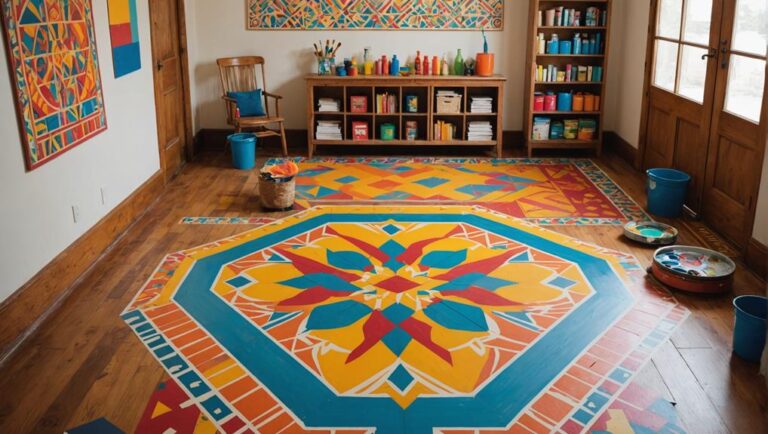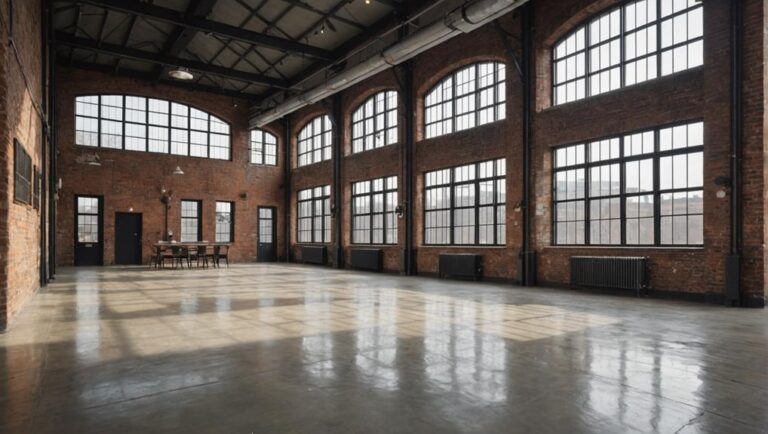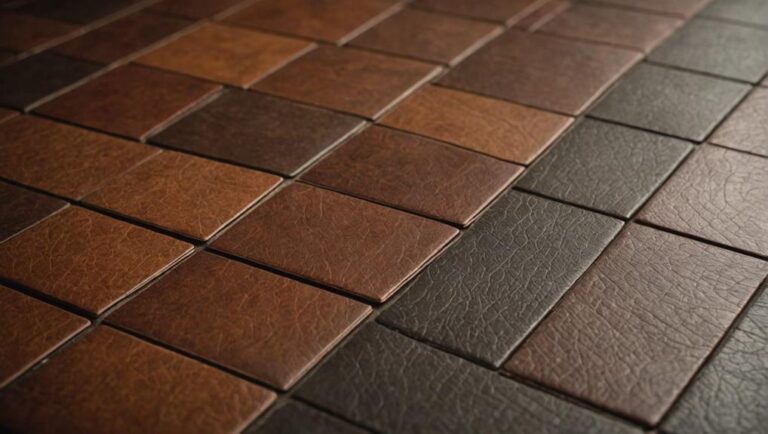To replace your floorboards without tearing out the entire floor, start by evaluating the damage. Identify which boards need replacing and measure for new ones. Gather essential tools like a pry bar, hammer, and circular saw, and prepare your workspace by clearing furniture and ensuring cleanliness. Carefully remove the damaged boards, check the subfloor, and install your new pieces, aligning them snugly. Secure the boards with nails and finish with sanding and sealing for a polished look. It's a manageable project, and as you consider the details, you might find more tips to streamline the process ahead.
Assessing the Damage
When it comes to evaluating the damage to your floorboards, your eyes can be your best tool. Start by inspecting each section closely, looking for common damage types like scratches, dents, or water stains. These issues can often be easily identified, but don't overlook any subtle signs of wear that could indicate deeper problems.
Once you've assessed the visible damage, consider the cause. For instance, moisture issues may require more than just surface repairs. If you find warping or buckling, it's vital to address any underlying water source before proceeding with repair options. Make a note of all the areas that need attention.
For minor scratches and dents, you might opt for a simple touch-up using wood filler or sanding. This can restore the floor's appearance without needing to replace entire boards. However, if you spot significant issues such as cracks or extensive water damage, you may need to replace individual boards.
Take measurements of the damaged areas, so you can find suitable replacement pieces later. Remember, when you repair or replace, it's important to match the wood type and finish for a seamless look.
Choosing Replacement Floorboards
Selecting the right replacement floorboards can make all the difference in restoring your space's aesthetic and functionality. When you're choosing new boards, consider the style options that will best fit your existing decor. Whether you prefer a sleek modern look or a rustic farmhouse vibe, there are plenty of choices available to complement your home's interior.
Next, think about material types. Hardwood, laminate, and engineered wood each offer distinct advantages. Hardwood provides durability and timeless beauty, but it can be pricier. Laminate, on the other hand, is often more budget-friendly and easier to install, though it may not have the same lifespan as hardwood. Engineered wood combines the best of both worlds, giving you the look of real wood with added stability against moisture.
Don't forget to match the finish and color of your new boards with the existing floor. This helps create a seamless swap that minimizes the appearance of repairs. If your current floor has a specific grain or hue, take a sample with you while shopping to guarantee a perfect match.
Lastly, consider safety features. If you've got pets or kids, look for materials that are scratch-resistant and easy to clean. Checking for low-VOC emissions is also essential for maintaining good indoor air quality. By carefully weighing your style options and material types, you can confidently choose replacement floorboards that enhance both your space and your peace of mind.
Gathering Necessary Tools
Before diving into your floorboard replacement project, it is vital to gather all the necessary tools to guarantee a smooth and efficient process. Having the right equipment not only enhances your workflow but also assures your safety while you work. Here are some essential tools you'll need, along with a few tool selection tips to help you choose wisely.
| Essential Tool | Purpose | Tool Selection Tips |
|---|---|---|
| Hammer | Removing old floorboards | Choose a claw hammer for easy prying. |
| Pry Bar | Lifting and removing boards | A flat pry bar works best for tight spaces. |
| Circular Saw | Cutting replacement boards | Verify it's sharp for clean cuts. |
| Measuring Tape | Measuring board lengths | Look for one that locks for accuracy. |
When selecting your tools, consider their quality. Investing in durable, reliable equipment can save you from potential injuries and frustrations during the project. If you're unsure about any items, don't hesitate to ask for recommendations at your local hardware store.
Make sure to wear safety gear, like gloves and goggles, to protect yourself while you work. A well-prepared toolkit can markedly enhance your overall experience, making the floorboard replacement process not just efficient but also enjoyable. By gathering these essential tools and keeping these tips in mind, you'll be ready to tackle your project with confidence.
Preparing the Work Area
Before you start replacing your floorboards, it's essential to prepare your work area properly. Clear the space of any furniture and debris, then gather all the tools you'll need for the job. Finally, assess the extent of any damage to guarantee you're ready for whatever challenges may arise during the project.
Clear the Workspace
Creating a safe and efficient workspace is essential for a successful floorboard replacement project. Start by removing any furniture or items obstructing your work area. This not only allows you to move freely but also minimizes the risk of accidents. Once the area is clear, ascertain your floor is clean and dry; any debris can create hazards or interfere with your work.
Next, think about workspace organization. Lay out your tools and materials in a way that keeps them easily accessible but also out of the way. Consider using a sturdy table or cart for storage, so you won't have to search for items mid-project. This saves time and reduces frustration.
Don't forget to take necessary safety precautions. If you're working in a confined space, ascertain there's adequate ventilation, especially if you're using adhesives or sealants. Wear appropriate safety gear, like gloves and goggles, to protect yourself from potential injuries. By prioritizing workspace organization and safety precautions, you'll set yourself up for a smoother and more efficient floorboard replacement process.
Gather Necessary Tools
With your workspace cleared and organized, it's time to gather the tools you'll need for replacing floorboards. Start by identifying the essential tool types: a pry bar, hammer, saw, measuring tape, and safety goggles. These tools will help you remove damaged boards and install new ones effectively.
Before you plunge into your project, verify your tools are in good condition. Proper tool maintenance is key for safety and efficiency. Check your saw's blade for sharpness and replace it if necessary. Make sure your pry bar is free of rust and can handle the pressure without bending. Having the right tools in their best condition will save you time and reduce the risk of accidents.
Don't forget to equip yourself with a dust mask and gloves. These safety items will protect you from debris and splinters while you work. Keeping your tools organized in a toolbox or on a workbench will also help you stay focused and prevent any unnecessary trips back and forth. With the right tools ready, you'll be set to tackle the task of replacing your floorboards safely and efficiently.
Assess Damage Extent
It's vital to thoroughly assess the extent of damage to your floorboards before diving into the replacement process. Start with a careful damage evaluation. Look for signs of warping, discoloration, or soft spots, as these can indicate more serious issues beneath the surface. Use a flashlight to inspect the seams and edges, noting any areas that need attention.
Next, prioritize your repairs based on severity. If you find minor surface damage, you might only need to sand and refinish those areas. However, if you spot extensive water damage or pest infestations, it's important to address those issues first, as they could compromise the integrity of your entire flooring system.
Be sure to document your findings. This will not only help you keep track of what needs to be repaired but also assist in sourcing the right materials for replacements. Remember, safety is key; wear protective gear, such as gloves and a mask, to avoid inhaling dust or harmful particles during your evaluation. By taking the time to assess the damage properly, you'll set the stage for a successful floorboard replacement that guarantees your space remains safe and beautiful.
Removing Damaged Floorboards
To start removing damaged floorboards, you need to assess the extent of the damage first. Once you've identified the problem areas, gather the necessary tools like a pry bar, saw, and safety gear. With everything ready, you're set to cut and remove the affected boards efficiently.
Assess Damage Extent
Evaluating the damage to your floorboards is essential before diving into the removal process. Start by using effective damage assessment techniques to determine the extent of the problem. A thorough visual inspection is your first step. Look for warping, discoloration, or soft spots that might indicate underlying moisture issues. Make sure to check around areas prone to spills or leaks; these are often hotspots for damage.
Next, gently press on the floorboards to detect any softness. If they give way, it's a sign that the damage is more serious and might require you to replace that section. Don't hesitate to pull up a corner of the flooring to inspect the subfloor beneath—this can reveal more about the damage's depth and help you plan your next steps.
Document your findings, noting any areas that need immediate attention. This information will be invaluable when you gather your necessary tools and materials. Remember, safety is key; if you find extensive damage or mold, consider consulting a professional before proceeding. Taking these careful steps now can save you time and trouble down the line.
Gather Necessary Tools
After evaluating the damage to your floorboards, the next step is gathering the right tools to remove the affected sections efficiently. Proper tool selection is key to guaranteeing a smooth process and minimizing damage to surrounding boards. You'll need a pry bar, a hammer, and a utility knife—these will help you lift and cut out the damaged boards safely.
Before you plunge in, don't forget about tool maintenance. Confirm your tools are in good condition; a dull knife or a rusty pry bar can make the job harder and more dangerous. Check that your hammer's handle is secure, and clean any dirt or debris from your tools. This not only prolongs their life but also enhances your safety as you work.
Additionally, wearing safety gear like gloves and goggles is a must. They'll protect you from splinters and debris while you handle the tools. Having a sturdy knee pad can also make the job more comfortable. With the right tools in hand and a focus on safety, you'll be well-prepared to tackle the next steps in replacing those damaged floorboards.
Cut and Remove
Now that you're equipped with the right tools, it's time to cut and remove the damaged floorboards. First, identify the floorboard types in your space—whether they're hardwood, laminate, or engineered wood—since this affects your cutting techniques. For hardwood, a jigsaw or circular saw works best. For laminate, a specialized laminate cutter or a fine-toothed saw is ideal.
Begin by marking the area you need to cut, making certain you stay clear of any nails or fasteners. Safety is key here: wear protective eyewear and a dust mask. Once marked, use your saw to carefully cut along the lines. If you're working with tongue-and-groove boards, make sure to slice through the groove to avoid damaging adjacent boards.
After making the cuts, you can gently pry up the damaged section using a pry bar. If you encounter stubborn boards, tap the pry bar with a hammer for extra leverage, but be cautious not to harm surrounding floorboards. Once removed, clean the area thoroughly, preparing it for the new floorboard installation. Following these steps will guarantee you safely and efficiently replace those damaged floorboards.
Installing New Floorboards
Installing new floorboards can be a rewarding DIY project that transforms the look and feel of your space. Before you get started, it's important to choose the right floorboard types for your home. Consider materials like hardwood, laminate, or engineered wood, each offering unique benefits. Hardwood provides a classic aesthetic, while laminate is budget-friendly and easy to maintain. Engineered wood can be a great compromise if you're looking for stability and style.
Once you've selected the perfect boards, it's time to focus on installation techniques. First, make sure your subfloor is clean, dry, and level. This not only helps with the longevity of your new floorboards but also guarantees a safe working environment. If you're using tongue-and-groove floorboards, you'll want to align the boards carefully, making sure each one fits snugly together.
When laying down the new boards, start at one corner of the room and work your way out, using spacers to maintain gaps for expansion. If you're installing floating floorboards, remember they shouldn't be glued or nailed down, allowing them to move freely. For nailed-down boards, pre-drilling holes can prevent splitting and make your job safer.
Lastly, don't forget to wear safety goggles and a dust mask while you work. These simple precautions will protect you from debris and promote a smooth and enjoyable installation process. With patience and attention to detail, you'll have beautiful new floorboards in no time!
Securing the Replacement Boards
Securing the replacement boards is essential to confirm your new floor remains stable and looks great for years to come. To effectively secure these boards, you've got a couple of reliable options: nailing techniques and adhesive options. Each method has its own advantages, so let's explore how to use them safely and effectively.
When considering nailing techniques, using finish nails or flooring nails is a solid choice. Make sure to angle your nails slightly to provide a stronger hold. A pneumatic nailer can speed up the process, but if you're using a hammer, be careful not to damage the wood. Always pre-drill your holes if you're working with hardwood to prevent splitting. This added step confirms both safety and durability.
If you prefer adhesive options, using a high-quality wood adhesive can create a seamless bond between the replacement boards and the existing floor. Apply the adhesive in a zigzag pattern across the board's bottom before laying it down. Confirm that you press the board firmly into place, allowing for proper adhesion. Be cautious with the amount you use; too much can lead to excess squeeze-out, which can be messy and unsightly.
Regardless of the method you choose, always follow manufacturer guidelines for both adhesives and nails. By securing the replacement boards using these techniques, you can confirm a sturdy, long-lasting floor that enhances the beauty of your space while keeping safety in mind.
Finishing Touches and Treatment
After replacing your floorboards, adding the right finishing touches is essential for achieving a polished look and protecting your investment. Start by sanding the new boards to create a smooth surface, guaranteeing they blend seamlessly with the existing flooring. Use a fine-grit sandpaper and take your time—this step is critical for a professional finish.
Next, consider your treatment options. Staining your floorboards can enhance their natural beauty and help unify the color throughout your space. Choose a stain that matches or complements your existing flooring. Always test the stain on a small, inconspicuous area first to verify it meets your expectations. Once you're satisfied, apply the stain using a clean cloth or brush, following the manufacturer's instructions for the best results.
After staining, it's time to seal your floorboards. This step is essential for protecting them from scratches, spills, and daily wear. You can select from various sealants, including polyurethane, which provides a durable, water-resistant finish. Make sure to choose a low-VOC or water-based option if you're concerned about indoor air quality. Apply the sealant evenly, allowing adequate drying time between coats.
Lastly, don't forget to add any finishing touches, like baseboards or trim, to complete the look. These details can enhance the overall aesthetic of your floor and create a polished appearance. With these finishing touches and treatment options in place, you'll guarantee your newly replaced floorboards are both beautiful and resilient.
Maintaining Your Floorboards
To keep your floorboards in top shape, regular cleaning is essential. You'll also want to inspect them for any signs of damage and know the right repair techniques to use when issues arise. By staying proactive, you can guarantee your floors look great and last for years to come.
Regular Cleaning Practices
Regular cleaning practices are essential to maintaining the beauty and longevity of your floorboards. By implementing a few simple cleaning techniques, you can guarantee that your floor stays in great shape and looks inviting for years to come. Here's how you can keep up with regular maintenance:
- Sweep or vacuum regularly: Remove dirt and debris to prevent scratches.
- Use a damp mop: Clean with a slightly damp mop; avoid soaking the floor.
- Choose the right cleaners: Use pH-balanced, non-abrasive cleaners designed for your floor type.
- Spot clean spills immediately: Wipe up spills to prevent stains or water damage.
- Avoid harsh chemicals: Steer clear of bleach or ammonia-based products that can harm the finish.
Inspecting for Damage
Inspecting your floorboards for damage is vital to preserving their integrity and appearance. Regular checks can help you catch problems early, preventing more extensive repairs down the line. Start by looking for identifying signs of wear, such as cracks, splinters, or discoloration. Pay attention to areas that experience heavy foot traffic, as these are more prone to damage.
Gather your inspecting tools before you begin. A flashlight can help you spot hidden issues, while a tape measure lets you check for any warping or unevenness. Don't forget to use a level to assess the floor's surface; irregularities could indicate underlying problems. As you inspect, tap on the boards with a hammer to listen for hollow sounds, which may signal that a board is loose or damaged.
Also, look for signs of moisture, like mold or water stains, especially in areas near entrances or plumbing. It's important to act promptly if you notice any damage, as this will help guarantee your floorboards remain safe and visually appealing. Regular inspections will keep your flooring in good shape and save you from costly repairs in the future.
Appropriate Repair Techniques
Maintaining your floorboards involves using the right repair techniques to guarantee their longevity and appearance. When you notice damage, it's crucial to act promptly to prevent further issues. Here are some effective repair techniques for floor restoration:
- Filling gaps: Use wood filler or caulk to fill in cracks and gaps, ensuring a smooth surface.
- Sanding: Lightly sand the affected area to remove rough spots and prepare it for refinishing.
- Staining: Match the existing color by applying a stain to blend the new repairs seamlessly with the surrounding wood.
- Sealing: Once you've finished staining, seal the area with a protective finish to guard against moisture and wear.
- Replacing boards: If damage is severe, consider replacing individual boards, ensuring they match the surrounding flooring.
When to Call a Professional
Deciding when to call a professional for replacing floorboards can be tricky, especially if you're unsure about the extent of the damage or the skills required for the job. You should look out for specific signs that indicate it's time to bring in an expert. If you notice extensive water damage, significant warping, or if multiple boards need replacement, these are clear signs a professional's help is needed.
Cost considerations also play an essential role in your decision. If the repair costs approach the price of hiring a pro, it might be worth opting for professional assistance right from the start. Sometimes, attempting a DIY fix can lead to more damage, ultimately increasing your expenses.
Additionally, if you lack the tools or experience necessary to complete the job safely, it's best to consult a specialist. Safety should always be your priority, as improper handling of flooring materials can lead to injuries.
When you're uncertain about your abilities or the complexity of the task, don't hesitate to reach out to a professional. They can offer insights on the issue and provide a thorough solution that guarantees the longevity of your flooring. Remember, investing in a professional could save you time, stress, and money in the long run. Trust your instincts, and if in doubt, it's often best to call in the experts.
Frequently Asked Questions
Can I Replace Floorboards in Any Type of Flooring?
You can replace floorboards in various floorboard types, but it often depends on the flooring methods used. For example, hardwood and laminate floorboards are generally easier to replace individually than carpet or tile. When tackling a replacement, make certain you've got the right tools and safety gear to prevent accidents. Always measure carefully to match the new floorboard with existing ones, maintaining a cohesive look while prioritizing your safety throughout the process.
How Do I Match the Color of Existing Floorboards?
To match the color of existing floorboards, you'll want to use effective color matching techniques. Start by evaluating the original floor's hue and undertones. Use stain application methods, like sampling on a hidden area or scrap piece, to find the perfect match. Always apply in thin layers and check for consistency. Don't forget to wear safety gear, ensuring proper ventilation while working to keep your environment safe and comfortable.
What if I Can't Find the Same Floorboard Style?
If you can't find the same floorboard style, don't worry; there are alternative flooring options you can explore. Consider using engineered wood or laminate that mimics your existing floor's look. Additionally, you can utilize floorboard repair techniques, like patching or staining, to blend mismatched boards seamlessly. Remember, safety's key, so guarantee the new materials are compatible with your home's environment. It'll help maintain your space's aesthetic while keeping it safe and functional.
How Long Does It Take to Replace Floorboards?
Replacing floorboards can feel like a dance, each step carefully planned. Time estimates for this project vary, usually ranging from a few hours to a couple of days, depending on the project complexity. If you're tackling a small area, you might finish quicker, but larger spaces or intricate designs will take longer. Always remember to prioritize safety by using the right tools and taking necessary precautions while you work.
Will Replacing Floorboards Affect My Home's Resale Value?
Replacing floorboards can definitely impact your home's resale potential. If you choose high-quality materials that enhance the flooring appeal, potential buyers might be more attracted to your property. However, poor choices could detract from its value. It's essential to guarantee the new floorboards match the existing style and quality of your home. Ultimately, a well-executed replacement can boost buyer interest and increase your chances of a successful sale.




